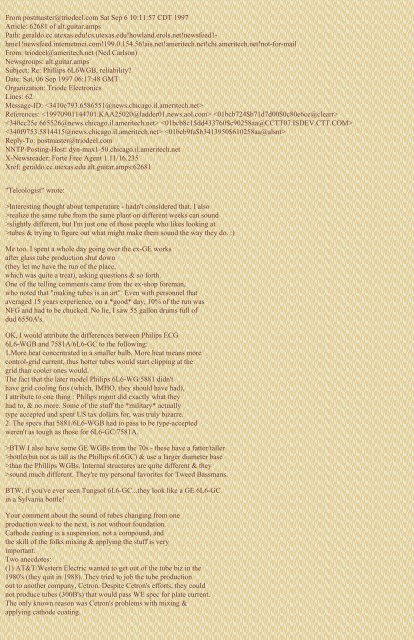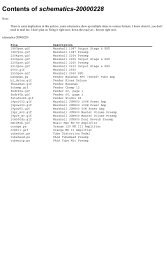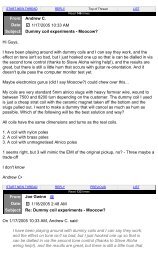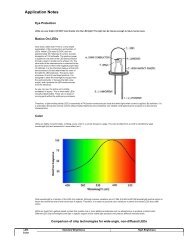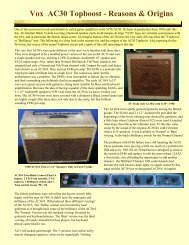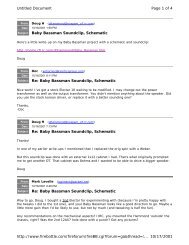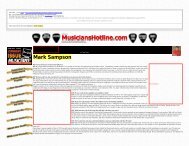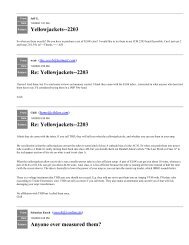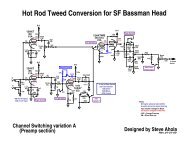Mic Kaczmarczik's TubeInformation - The Blue Guitar
Mic Kaczmarczik's TubeInformation - The Blue Guitar
Mic Kaczmarczik's TubeInformation - The Blue Guitar
Create successful ePaper yourself
Turn your PDF publications into a flip-book with our unique Google optimized e-Paper software.
From postmaster@triodeel.com Sat Sep 6 10:11:57 CDT 1997<br />
Article: 62681 of alt.guitar.amps<br />
Path: geraldo.cc.utexas.edu!cs.utexas.edu!howland.erols.net!newsfeed1-<br />
hme1!newsfeed.internetmci.com!199.0.154.56!ais.net!ameritech.net!chi.ameritech.net!not-for-mail<br />
From: triodeel@ameritech.net (Ned Carlson)<br />
Newsgroups: alt.guitar.amps<br />
Subject: Re: Phillips 6L6WGB, reliability?<br />
Date: Sat, 06 Sep 1997 06:17:48 GMT<br />
Organization: Triode Electronics<br />
Lines: 62<br />
Message-ID: <br />
References: <br />
<br />
<br />
Reply-To: postmaster@triodeel.com<br />
NNTP-Posting-Host: dyn-max1-50.chicago.il.ameritech.net<br />
X-Newsreader: Forte Free Agent 1.11/16.235<br />
Xref: geraldo.cc.utexas.edu alt.guitar.amps:62681<br />
"Teleologist" wrote:<br />
>Interesting thought about temperature - hadn't considered that. I also<br />
>realize the same tube from the same plant on different weeks can sound<br />
>slightly different, but I'm just one of those people who likes looking at<br />
>tubes & trying to figure out what might make them sound the way they do. :)<br />
Me too. I spent a whole day going over the ex-GE works<br />
after glass tube production shut down<br />
(they let me have the run of the place,<br />
which was quite a treat), asking questions & so forth.<br />
One of the telling comments came from the ex-shop foreman,<br />
who noted that "making tubes is an art". Even with personnel that<br />
averaged 15 years experience, on a *good* day, 10% of the run was<br />
NFG and had to be chucked. No lie, I saw 55 gallon drums full of<br />
dud 6550A's.<br />
OK, I would attribute the differences between Philips ECG<br />
6L6-WGB and 7581A/6L6-GC to the following:<br />
1.More heat concentrated in a smaller bulb. More heat means more<br />
control-grid current, thus hotter tubes would start clipping at the<br />
grid than cooler ones would.<br />
<strong>The</strong> fact that the later model Philips 6L6-WG/5881 didn't<br />
have grid cooling fins (which, IMHO, they should have had),<br />
I attribute to one thing : Philips mgmt did exactly what they<br />
had to, & no more. Some of the stuff the *military* actually<br />
type accepted and spent US tax dollars for, was truly bizarre.<br />
2. <strong>The</strong> specs that 5881/6L6-WGB had to pass to be type-accepted<br />
weren't as tough as those for 6L6-GC/7581A.<br />
>BTW I also have some GE WGBs from the 70s - these have a fatter/taller<br />
>bottle(but not as tall as the Phillips 6L6GC) & use a larger diameter base<br />
>than the Phillips WGBs. Internal structures are quite different & they<br />
>sound much different. <strong>The</strong>y're my personal favorites for Tweed Bassmans.<br />
BTW, if you've ever seen Tungsol 6L6-GC...they look like a GE 6L6-GC<br />
in a Sylvania bottle!<br />
Your comment about the sound of tubes changing from one<br />
production week to the next, is not without foundation.<br />
Cathode coating is a suspension, not a compound, and<br />
the skill of the folks mixing & applying the stuff is very<br />
important.<br />
Two anecdotes:<br />
(1) AT&T/Western Electric wanted to get out of the tube biz in the<br />
1980's (they quit in 1988). <strong>The</strong>y tried to job the tube production<br />
out to another company, Cetron. Despite Cetron's efforts, they could<br />
not produce tubes (300B's) that would pass WE spec for plate current.<br />
<strong>The</strong> only known reason was Cetron's problems with mixing &<br />
applying cathode coating.


